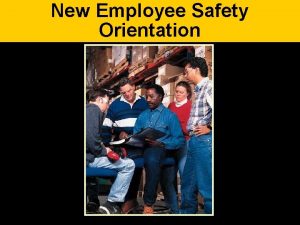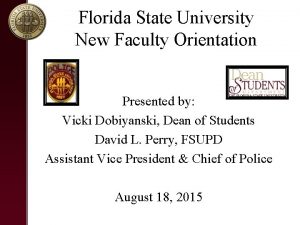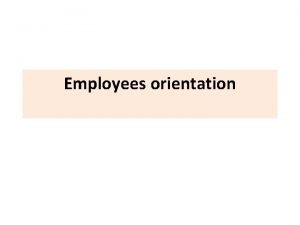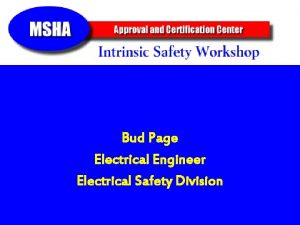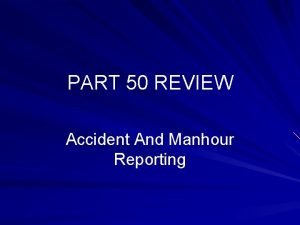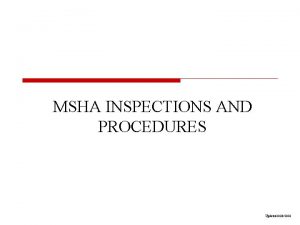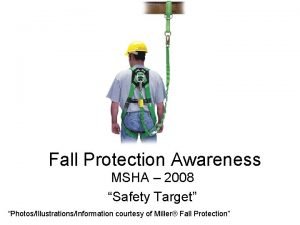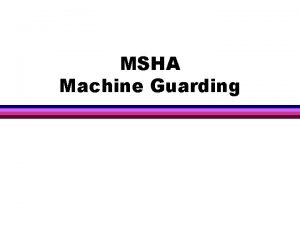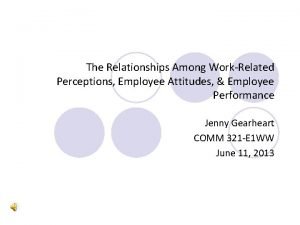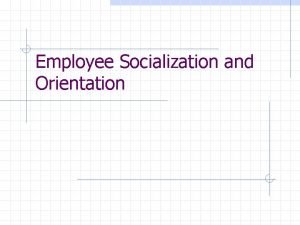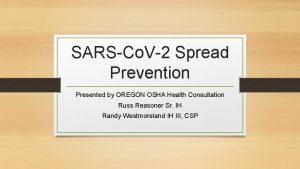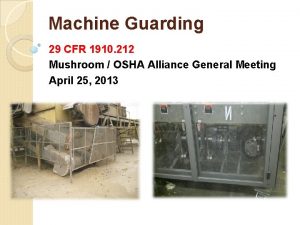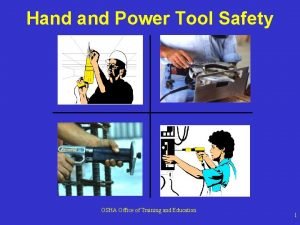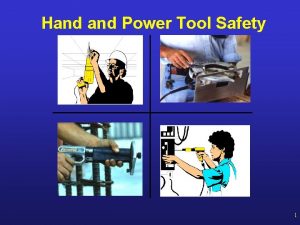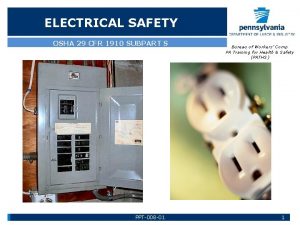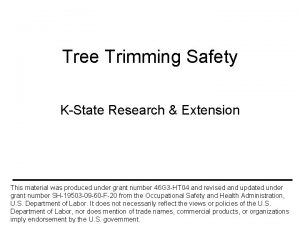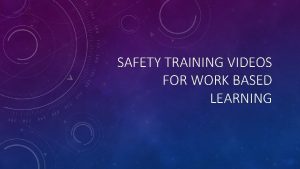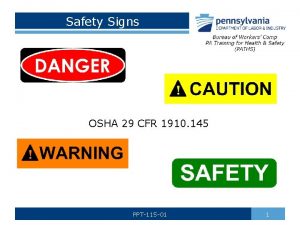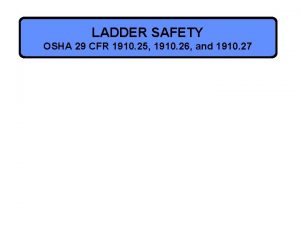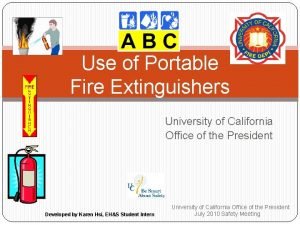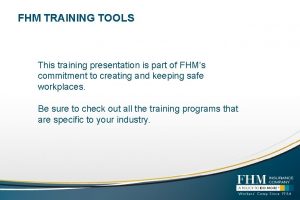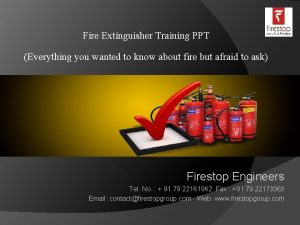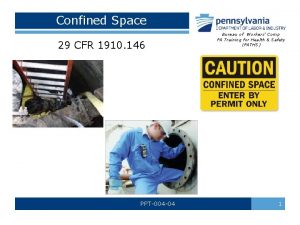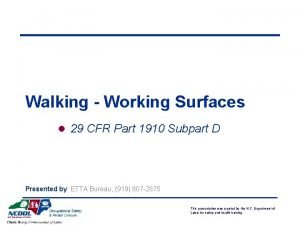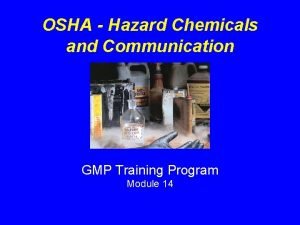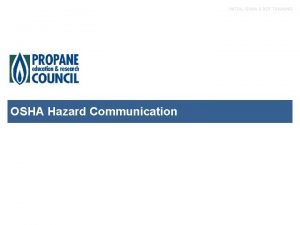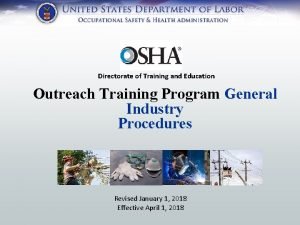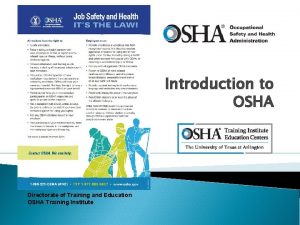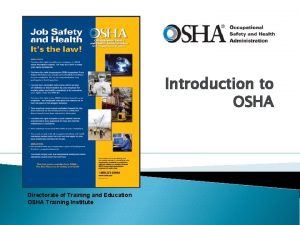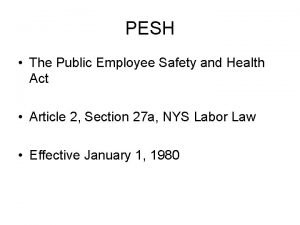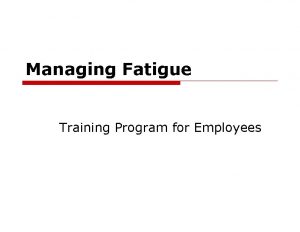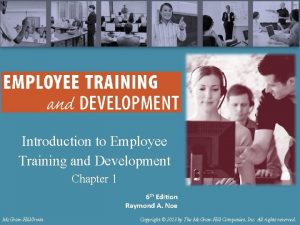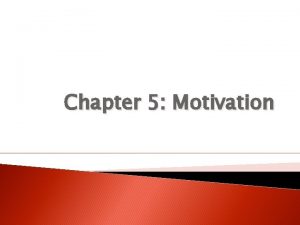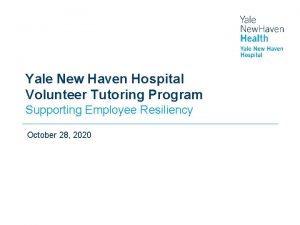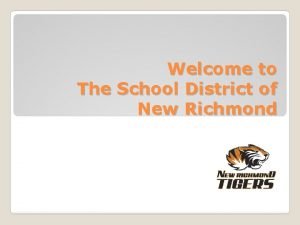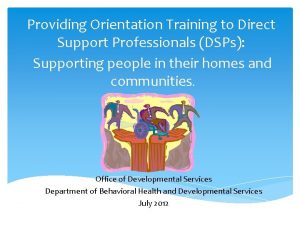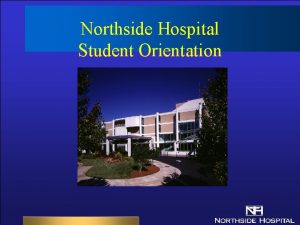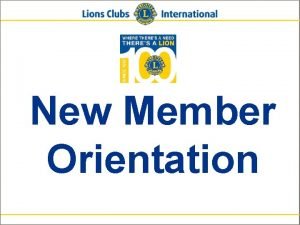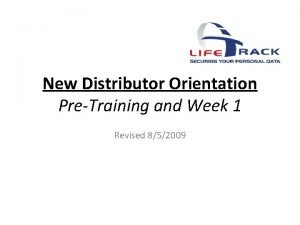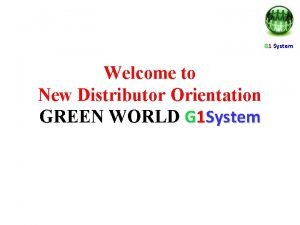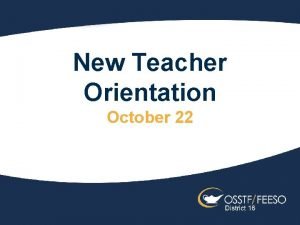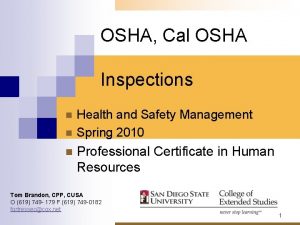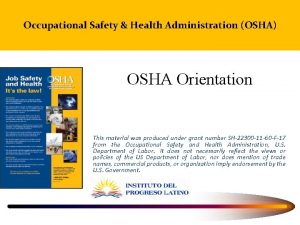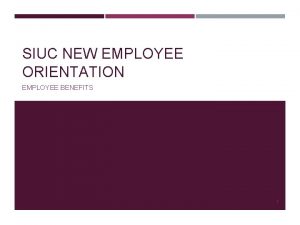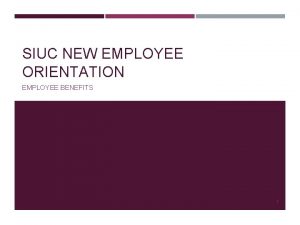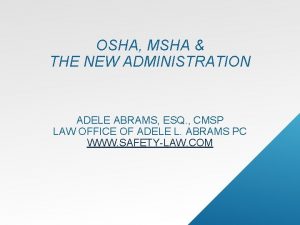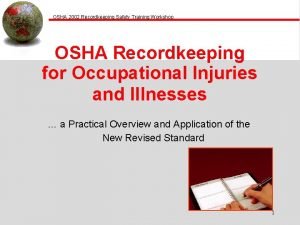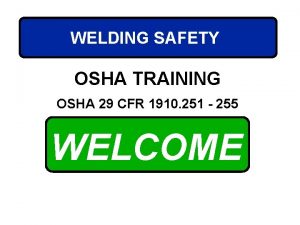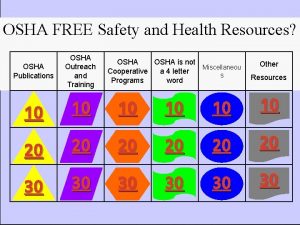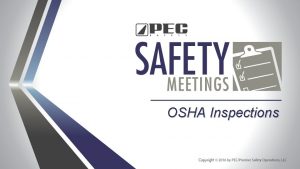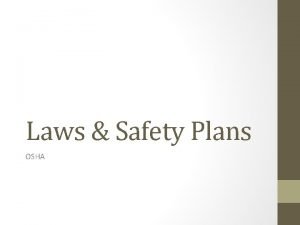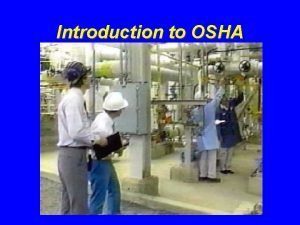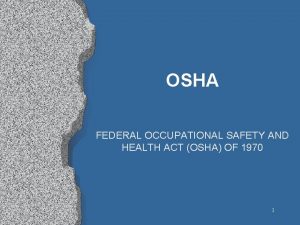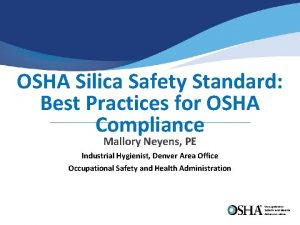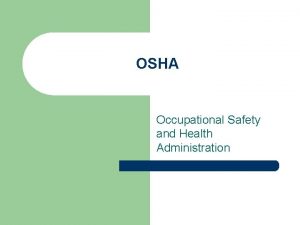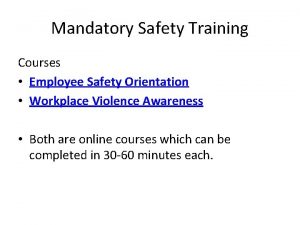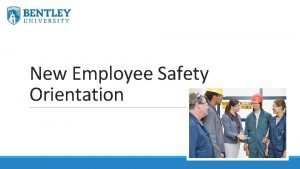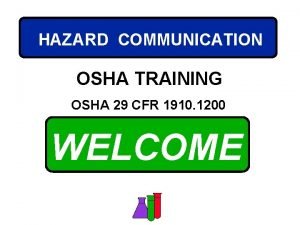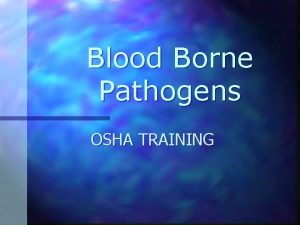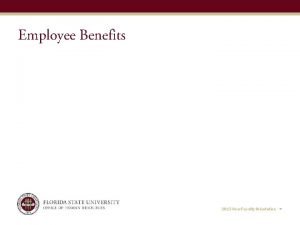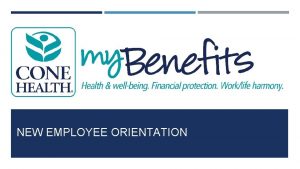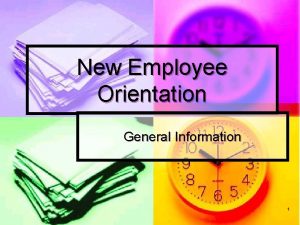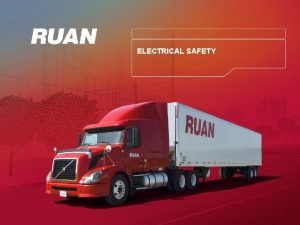NEW EMPLOYEE SAFETY ORIENTATION OSHA MSHA TRAINING 29



















































- Slides: 51

NEW EMPLOYEE SAFETY ORIENTATION OSHA / MSHA TRAINING 29 CFR 1910 and 30 CFR Part 46, Part 48 Revised: November 1999

29 CFR (Code of Federal Regulations) Provides regulatory guidance for industrial applications.

The General Duty Clause: Purpose: The General Duty Clause provides enforcement action where no specific OSHA regulations cover a particular hazard. FEDERAL - 29 CFR 1903. 1 EMPLOYERS MUST: Furnish a place of employment free of recognized hazards that are causing or are likely to cause death or serious physical harm to employees. Employers must comply with occupational safety and health standards promulgated under the Williams-Steiger Occupational Safety and Health Act of 1970.

Safety Statistics o. Fourteen thousand Americans die from onthe-job accidents every year o. A worker is injured every 19 seconds o. Most accidents occur within an employee’s first six months on a new job

*Awareness Level Orientation *Introduction to Merrick Safety Programs *Emergency Information *“On The Job Training” *Safety Bulletin Boards and Newsletter *Safety Incentive Program

The personal safety and health of each employee of this company is of primary importance. The prevention of occupationally-induced injuries and illnesses is of such consequence that it will be given precedence over operating productivity whenever necessary. To the greatest degree possible, this company will provide all mechanical and physical facilities required for personal safety and health in keeping with the highest standards.

Safety and Health Program Guidelines Employer Responsibilities þ Management is committed to safety. þ Provide a workplace free of hazards through hazard Identification, assessment, prevention and control. þ Establish written safety programs. þ Provide education and training. þ Review and evaluate all programs on an annual basis.

Safety and Health Program Guidelines Employee Responsibilities Team Work ZRead the OSHA poster ZFollow all OSHA standards ZFollow all safety and health rules ZReport any hazardous conditions ZReport any job related illness ZExercise your rights responsibly

GENERAL SAFETY RULES All Departments Read the General Safety Rules Know the safety rules which apply to your job. • Observe all safety warning signs • Disciplinary actions Merrick RULES

Accident Prevention 29 CFR 1910. 145 Merrick Safety PROGRAM t. All industrial Accidents and Illness must be reported t. Near misses should also be reported t. Obtain an accident report form at the first aid station. t. Employees not located at the Lynn Haven facility may obtain a form from the Manager of Manufacturing or the Safety Coordinator

Accident Prevention 29 CFR 1910. 145 Specifications for Accident Prevention Signs and Tags: Potential Hazards Immediate Danger General Safety

Medical Services and First Aid þ First aid supplies are readily available and accessible. þ Permanent eye wash stations are provided and are located throughout the facility. þ Employees are available at this facility that are Red Cross CPR and First Aid Certified.

Access To Medical and Exposure Records • Access - the right and opportunity to examine and copy. • Exposure Records - records that indicate the identity, amount and nature of toxic substances or harmful physical agents that the employee has been exposed to. • Medical Records - employer must provide employees and their designated representatives access to medical records relevant to the employee. • Analysis using Exposure or Medical Records - employees, representatives, or OSHA can have access to analyses that were developed from information from exposure or medical records.

Access To Medical and Exposure Records • Trade Secrets - an employer may withhold trade secrets information but must provide information needed to protect employee health. • Employee Information - at the time of initial employment and annually, employees must be told of the existence, location and availability of their medical and exposure records. • Transfer of Records - employer is required to provide the successor employer with all records. • Retention of Records - exposure records kept for 30 years, medical records kept for duration of employment plus 30 years.

Emergency Preparedness & Response EMERGENCY ACTIONS 29 CFR 1910. 37 -38, 157, 160 Merrick Safety PROGRAM þ Know your evacuation route. þ Know where the evacuation muster area is for your work area. þ If you evacuate to the muster area, you must not leave until you are released by management. We must be able to account for all employees. þ It is everyone’s responsibility to notify supervision of fires and other emergencies! Never assume someone else has made the call. þ Escorts are responsible for visitors. Escorts must brief visitors concerning evacuation procedures.

Emergency Preparedness & Response 29 CFR 1910. 37 -38, 157, 160 þ Know the signal that indicates you should evacuate your work area. þ Fire extinguishers are strategically located everywhere in the facility. Know where they are in your work area. þ If you use an extinguisher always point the extinguishing stream at the base of the fire. þ Never underestimate the travel speed of fire and the seriousness of open flames in an industrial environment.

Facility Tour

Personal Protective Equipment At Your Specific Job, You Will Learn: • When protection is needed • What kind of protection • How to use protection • Limitations of protection • How to maintain, care for and dispose of protection

Personal Protective Equipment 29 CFR 1910. 132 Safety shoes are not required when passing through the shop in the safety aisles, but are required when working in, or out of, the safety aisles. They may also be required in specially designated areas. Safety glasses with side shields are required in the shop and other designated areas at all times. In addition to safety glasses, face shields must be worn when grinding metal. Follow local job procedures concerning PPE selection, use and maintenance.

Respiratory Protection 29 CFR 1910. 139 Merrick Safety PROGRAM The OSHA Respiratory Protection Standard establishes uniform requirements to make sure that the respiratory hazards of all U. S. workplaces are evaluated, and that engineering and work practice controls are implemented. • Respirator users must have medical exams and certified as being able to safely wear the respirator.

Hearing Conservation 29 CFR 1910. 95 Merrick Safety PROGRAM Noise is Everywhere! OSHA requires: þ Regular program evaluations, with annual Audiograms. þ Work area noise surveillance. Must be below 85 d. BA. þ Proper selection of noise exposure equipment. þ Inspection, cleaning, maintenance and storage of equipment.

Ergonomics 29 CFR 1910 Merrick Safety PROGRAM Ergonomics is the science of fitting the job to the worker. When there is a mismatch between the physical requirements of the job and the physical capacity of the worker, work-related musculoskeletal disorders (WMSDs) can result. WMSDs now account for 34 % of all lost workday injuries and illnesses.

Ergonomics 29 CFR 1910 Keys to Success Reduce: wrepeated motion wforceful hand exertions w. Working above shoulder height wprolonged bending wvibration Rely on equipment - not backs - for heavy or repetitive lifting. Provide “micro” breaks to allow muscles to recover.

Ergonomics 29 CFR 1910 Safety Tips for Lifting • Don’t lift objects over your head. • Don’t twist your body when lifting or setting an object down. • Don’t reach over an obstacle to lift a load. • Squat down, bending your knees - not your back. • Use your legs to bring you to a standing position. • Pace yourself to avoid fatigue when doing heavy work for a long period of time.

HAZARD COMMUNICATION 29 CFR 1910. 1200 Hazardous Chemical: Any Chemical whose presence or use is a Physical or a Health Hazard Physical Hazards Health Hazards Flammable liquids or solids Combustible liquids Compressed gases Explosives Organic peroxide Oxidizers Pyrophoric materials Unstable materials Water reactive materials Carcinogens Toxic agents Reproductive toxins Irritants Corrosives Sensitizers Organ - specific agents

HAZARD COMMUNICATION 29 CFR 1910. 1200 Merrick Safety PROGRAM Material Safety Data Sheets ËMSDS are prepared by the chemical manufacturer to provide additional information concerning the safe use of the product. ËMSDS are filed by proper name, therefore it is important to know the chemicals’ proper name in order to find the correct MSDS. ËYou are authorized to obtain a copy of any MSDS. They are located in the Shop Supervisors office and in the Safety Coordinators office.

MSDS

MSDS

MSDS

MSDS

MSDS

MSDS

BLOODBORNE PATHOGEN 29 CFR 1910. 1030 What are …. . BLOODBORNE Pathogens? ( Microorganisms that may be present in human blood and are capable of producing serious illness and disease. ( Occupational Exposure can occur through accidental punctures or contact between broken or damaged skin, mucous membranes and infected body fluids. ( Always use Universal Precautions: Assume all body fluids are potentially infectious. ( Use the correct clean-up procedures with an EPA approved HIV / HBV disinfectant.

Electrical Safety 29 CFR 1910. . 331 -. 335; 1926. 416 -. 417 Electrical injuries consist of four main types A Electric shock A Burns A Falls (From contact with electrical energy) A Electrocution Follow Job Site Procedures for Lockout / Tagout Electricity Causes 10% of Job Related Deaths

Lockout - Tagout 29 CFR 1910. 147 Merrick Safety PROGRAM DANGER þ The person who locks or tags out LOCKED OUT DO NOT OPERATE This Lock/Tag may only be removed by NAME: ________ DEPT : ________ EXPECTED COMPLETION DATE: ________ TIME: _________ AUTHORIZED EMPLOYEE machines to maintenance. þ perform servicing or AFFECTED EMPLOYEE An employee whose job requires him or her to operate or use a machine or piece of equipment on which servicing or maintenance is being performed.

Power Tool Safety 29 CFR 1910. 241 -. 246; 1926. 302 o. Inspect tools thoroughly before each use o. Ensure electrical cords are grounded o. Never defeat the grounding terminal o. Be aware of water hazards o. Limit conversation while using tools o. Avoid horseplay - don’t tolerate it from others o. Always wear personal protective equipment

Hand Tool Safety 29 CFR 1910. 242; 1926. 300 -. 305 p. Inspect tools thoroughly before each use p. Select the correct tool for the specific job p. Limit conversations while using tools p. Avoid horseplay - don’t tolerate it from others p. Do not force tools p. Always wear personal protective equipment

Machine Guarding 29 CFR 1910. 211 - 222 Hazardous Mechanical Motions and Actions A wide variety of mechanical motions and actions may present hazards to the worker: þ þ þ Rotating members Reciprocating arms Moving belts Meshing gears Cutting teeth Any parts that impact or shear Do Not Remove Any Guards From Equipment!

Welding 29 CFR 1910. 251 -. 257; 1926. 350 -. 354 General Welding Hazards

Compressed Gas 29 CFR 1910. 101; 1926. 350(a) þ THE TYPICAL COMPRESSED GAS CYLINDER: ü 175 Pounds. ü 2, 000 to 2, 640 psig (some to 6, 000 psig). ü Wall Thickness of About 1/4 Inch. ü 57 Inches Tall. ü 9 Inches In Diameter. ü Easily Toppled. ü Easily Corroded. ü Devastatingly Hazardous. DANGER ACETYLENE NO SMOKING NO FUMAR 1 GAS INSPECTION CHECKLIST 4 3

Compressed Gas 29 CFR 1910. 101 Mixtures of fuel gases and air or oxygen may be explosive and must be guarded against. ü Oxidizers: Must not be used in contact with oils, greases or other hydrocarbons. ü Flammables: Must not be exposed to flames, sparks or arcs including static electricity, hot surfaces or oxidizers. ü Non-Flammables: Must not be allowed to displace air in confined work spaces so that there is insufficient oxygen for breathing. DANGER COMPRESSED GAS STORAGE AREA

Fall Protection 29 CFR 1926. 500 -. 503 The prevention of injury through the use of planned, active protective systems: þ þ þ þ Roof Systems Rescue Systems Retrieval Systems Restraint Systems Fall Arrest Systems Suspension Systems Ladder Safety

Fall Protection Equipment Inspection Before Use: Employees using fall equipment must inspect their own equipment before every use. Do not place your life in someone else’s hands! Defective components must be removed from service if their function or strength has been adversely affected. Consult the Fall Protection Safety Program for detailed information.

Confined Space 29 CFR 1910. 146 Merrick Safety PROGRAM CONFINED SPACE: þ Limited or restricted means of entry and exit þ Not designed for continuous human occupancy þ Large enough and so configured to enter for work PERMIT REQUIRED CONFINED SPACE: þ Contains a hazardous atmosphere or the potential þ Contains engulfment potential þ Internal configuration that could trap an entrant þ Contains any other serious safety or health hazard NON-PERMIT CONFINED SPACE: þ No potential to develop hazards þ No atmospheric, safety, or health hazards

Video Display Terminals 29 CFR 1910 • Working with a VDT places a number of demands and stresses upon the operator. • VDT operators will learn how the arrangement and placement of your work station can influence your comfort and productivity.

Heat Stress Working in a hot environment lowers the mental alertness and physical performance of an individual. Excessive exposure to a hot work environment can bring about a variety of heat-induced disorders. • • Heat Stroke Heat Exhaustion Heat Cramps Fainting

Walking and Working Surfaces 29 CFR 1910. 22 • Practice Good Housekeeping • Practice Ladder Safety • Keep Aisles and Passageways Clear

Powered Lifts & Trucks 29 CFR 1910. 178 Forklift Safety Includes You! • Be Aware of Pedestrians • Follow Safe Operation Procedures • No Riders! • No Horseplay! • All Drivers Must Be Trained and Certified

Indoor Crane & Sling 29 CFR 1910. 179, 184 Crane Safety Includes You! • Be Aware of Pedestrians • Follow Safe Operation Procedures • No Horseplay! • All Crane Operators Must Be Trained and Certified

You have just completed the New Employee Safety Orientation! Welcome to !!!

New Employee Orientation Name: ______________________________________________ Date: ______________Job Description: __________________________ Safety Topics Presented During New Employee Orientation q. Intro to 29 CFR OSHA q. General Duty Clause q. Safety Statistics q. Safety Program Introduction q. Company Safety Policy q. Employer / Employee Responsibilities q. General Safety Rules q. Accident Prevention - Reporting Accidents q. Accident Prevention - Signs q. Medical Services and First Aid q. Access to Medical and Exposure Records q. Bloodborne Pathogen q. Emergency Preparedness and Response q. Evacuation Plans q. Fire Emergencies q. Personal Protective Equipment q. Respiratory Protection q. Hearing Conservation q. Ergonomics q. Safe Lifting Tips q. Hazard Communication / MSDS q. Electrical Safety q. Lockout Tagout q. Power Tool Safety q. Hand Tool Safety q. Machine Guarding q. Welding q. Compressed Gas q. Fall Protection q. Confined Space q. Video Display Terminals q. Heat Stress q. Walking and Working Surfaces q. Powered Trucks q. Crane and Sling Employee : ______________________ Trainer: ______________________
 Employee safety orientation quiz answers
Employee safety orientation quiz answers Nih new employee orientation
Nih new employee orientation Florida state university orientation
Florida state university orientation New employee orientation
New employee orientation Basic safety orientation
Basic safety orientation Basic safety construction site safety orientation
Basic safety construction site safety orientation Msha organizational chart
Msha organizational chart Msha form 7000-2
Msha form 7000-2 Msha dirty dozen
Msha dirty dozen Msha part 56
Msha part 56 Msha fall protection standard
Msha fall protection standard Tail pulley guard
Tail pulley guard Msha immediately reportable
Msha immediately reportable Employee attitudes and employee performance
Employee attitudes and employee performance Safety care behavioral safety training
Safety care behavioral safety training Feldman's model of organizational socialization
Feldman's model of organizational socialization Polycentric management orientation
Polycentric management orientation Osha safety pyramid
Osha safety pyramid 29 cfr 1910
29 cfr 1910 Osha hand and power tool safety
Osha hand and power tool safety Osha power tool safety
Osha power tool safety 29 cfr 1910 subpart s
29 cfr 1910 subpart s 54 year old tree trimming accident
54 year old tree trimming accident Osha training videos
Osha training videos Osha safety symbols
Osha safety symbols Osha robot safety
Osha robot safety Osha ladder storage
Osha ladder storage Cal osha fire extinguisher requirements
Cal osha fire extinguisher requirements Osha yard tractor training
Osha yard tractor training Firefighter motto
Firefighter motto Osha confined space training powerpoint
Osha confined space training powerpoint Cfr 1910
Cfr 1910 Osha hazard and ghs training regulation cfr 1910
Osha hazard and ghs training regulation cfr 1910 Osha hazard communication inital training
Osha hazard communication inital training Osha directorate of training and education
Osha directorate of training and education Osha directorate of training and education
Osha directorate of training and education Osha directorate of training and education
Osha directorate of training and education Exposure control plan
Exposure control plan Chapter 16: employee safety and health
Chapter 16: employee safety and health Employee fatigue training
Employee fatigue training Introduction to employee training and development
Introduction to employee training and development Employee training methods
Employee training methods Employee motivation a powerful new model
Employee motivation a powerful new model Yale hr connect
Yale hr connect Skyward new richmond
Skyward new richmond Dbhds values direct support professionals who
Dbhds values direct support professionals who Northside hospital new hire orientation
Northside hospital new hire orientation Lions club member benefits
Lions club member benefits New distributor orientation
New distributor orientation New distributor orientation program
New distributor orientation program Toastmasters new member orientation
Toastmasters new member orientation New teacher orientation agenda
New teacher orientation agenda
